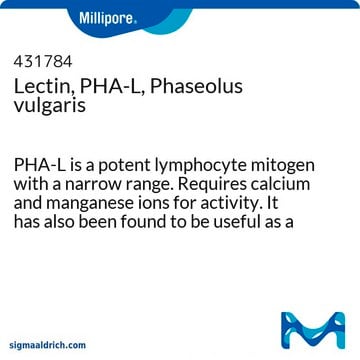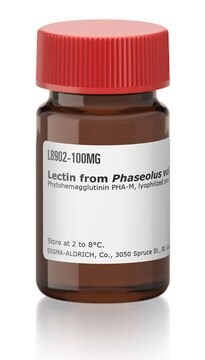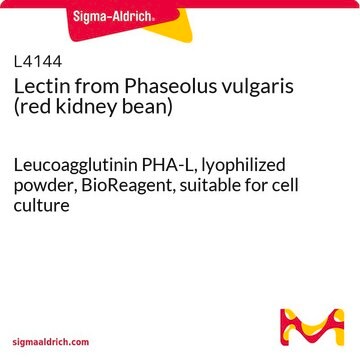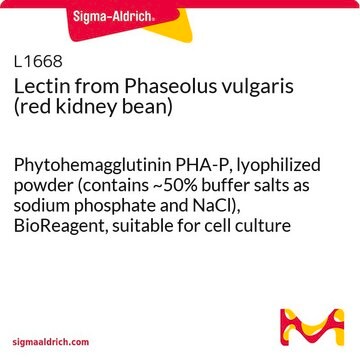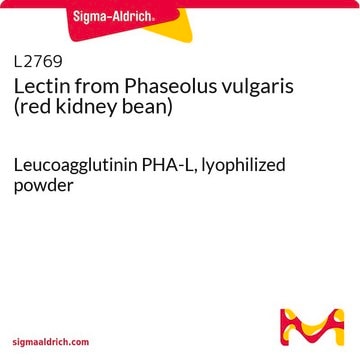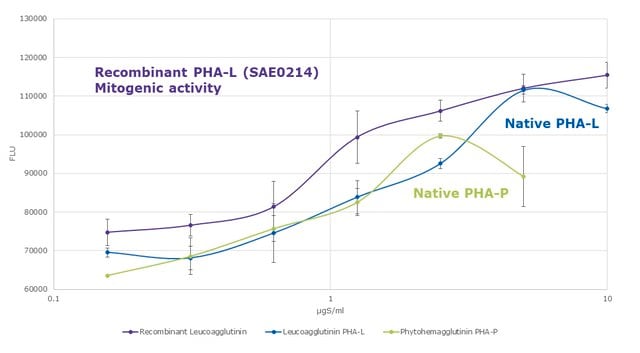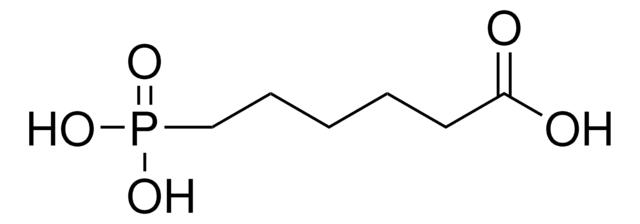11249738001
Roche
Phytohemagglutinin-L (PHA-L)
from Phaseolus vulgaris
Synonyme(s) :
PHA-L
Se connecterpour consulter vos tarifs contractuels et ceux de votre entreprise/organisme
About This Item
Code UNSPSC :
23201100
Produits recommandés
Niveau de qualité
Stérilité
non-sterile; 0.2 μm filtered
Pureté
>95% (SDS-PAGE)
Forme
lyophilized (clear, colorless solution after reconstitution)
Conditionnement
pkg of 5 mg
Fabricant/nom de marque
Roche
Application(s)
hematology
Température de stockage
2-8°C
Description générale
PHA-L is purified from Phaseolus vulgaris (red kidney bean) by standard chromatographic techniques.
Phytohemagglutinin (PHA), the lectin extract from the red kidney bean, consists of only L-type subunits (isolectin L4, "leuko-agglutinin"). It is an N-acetylgalactosamine/galactose sugar-specific lectin. PHA consists of five isolectins (L4E0, L3E1, L2E2, L1E3, L0E4) each being a tetramer held together by noncovalent forces. The subunits L (leukocyte reactive) have a high affinity for lymphocyte surface receptors, but little for those of erythrocytes, and are responsible for the mitogenic properties of the isolectins. E (erythrocyte reactive) is responsible for the erythrocyte-agglutinating properties.
Phytohemagglutinin (PHA), the lectin extract from the red kidney bean, consists of only L-type subunits (isolectin L4, "leuko-agglutinin"). It is an N-acetylgalactosamine/galactose sugar-specific lectin. PHA consists of five isolectins (L4E0, L3E1, L2E2, L1E3, L0E4) each being a tetramer held together by noncovalent forces. The subunits L (leukocyte reactive) have a high affinity for lymphocyte surface receptors, but little for those of erythrocytes, and are responsible for the mitogenic properties of the isolectins. E (erythrocyte reactive) is responsible for the erythrocyte-agglutinating properties.
Application
Phytohemagglutinin-L (PHA-L) consists of only L-type subunits (isolectin L4, "leuko-agglutinin"), and is well suited for high-efficiency induction and the functional analysis of T-lymphocytes. It is highly purified and tested for high-efficiency stimulation of human lymphocytes. It is also used as positive controls for peripheral blood mononuclear cells (PBMC) stimulation.
Actions biochimiques/physiologiques
Phytohemagglutinin (PHA) has mitogenic and potent cell agglutinating activities. It binds to T-cell membranes and stimulates cell division and metabolic activity. PHA has the ability to stimulate close contacts between cell membranes.
Caractéristiques
Biological activity: <5μg/ml for maximal stimulation of DNA synthesis (BrdU incorporation) with human peripheral blood lymphocytes
Séquence
PHA-L is a tetramer of 4 L-type subunits held together by noncovalent forces.
Notes préparatoires
Working concentration: 1 to 5 μg/ml
Approximately 1 to 5 μg/ml for the stimulation of human peripheral blood lymphocytes
Storage conditions (working solution): -15 to -25 °C
The reconstituted solution is stable at -15 to -25 °C.
Note: Store the reconstituted solution in aliquots at -15 to -25 °C.
Avoid repeated freezing and thawing.
Approximately 1 to 5 μg/ml for the stimulation of human peripheral blood lymphocytes
Storage conditions (working solution): -15 to -25 °C
The reconstituted solution is stable at -15 to -25 °C.
Note: Store the reconstituted solution in aliquots at -15 to -25 °C.
Avoid repeated freezing and thawing.
Autres remarques
For life science research only. Not for use in diagnostic procedures.
Code de la classe de stockage
11 - Combustible Solids
Classe de danger pour l'eau (WGK)
WGK 2
Point d'éclair (°F)
Not applicable
Point d'éclair (°C)
Not applicable
Certificats d'analyse (COA)
Recherchez un Certificats d'analyse (COA) en saisissant le numéro de lot du produit. Les numéros de lot figurent sur l'étiquette du produit après les mots "Lot" ou "Batch".
Déjà en possession de ce produit ?
Retrouvez la documentation relative aux produits que vous avez récemment achetés dans la Bibliothèque de documents.
Les clients ont également consulté
An optimized IFN-γ ELISpot assay for the sensitive and standardized monitoring of CMV protein-reactive effector cells of cell-mediated immunity.
Barabas S, et al.
BMC Immunology, 18(1), 14-14 (2017)
ELISPOT Assay to Measure Peptide-specific IFN-γ Production.
Wykes M N and Renia L.
Bio-protocol, 7(11) (2017)
Geng Liu et al.
Communications biology, 6(1), 102-102 (2023-01-27)
Protein acetylation plays a key role in regulating cellular processes and is subject to aberrant control in diverse pathologies. Although histone deacetylase (HDAC) inhibitors are approved drugs for certain cancers, it is not known whether they can be deployed in
Jian-Fei Hu et al.
Frontiers in immunology, 13, 958960-958960 (2022-08-23)
Chimeric antigen receptor-engineered T cell (CAR-T) therapy has shown promising potential for anti-cancer treatment. However, for pancreatic ductal adenocarcinoma (PDAC), the lack of infiltrative ability of these CAR-T cells leads to sub-optimal treatment outcome. Chemokine (C-C motif) ligand 19 (CCL19)
Mengze Song et al.
International journal of molecular sciences, 24(2) (2023-01-22)
Bone health problems are a serious threat to laying hens; microbiome-based therapies, which are harmless and inexpensive, may be an effective solution for bone health problems. Here, we examined the impacts of supplementation with Clostridium butyricum (CB) on bone and
Notre équipe de scientifiques dispose d'une expérience dans tous les secteurs de la recherche, notamment en sciences de la vie, science des matériaux, synthèse chimique, chromatographie, analyse et dans de nombreux autres domaines..
Contacter notre Service technique
